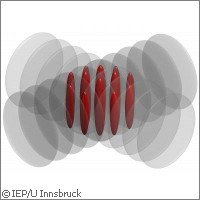Sep 7 2009
EU-funded researchers in Austria investigating ultracold atomic physics have generated an exotic state wherein atoms are aligned in a one-dimensional structure, creating a stable 'many-body phase' with new quantum mechanical states. Their findings, published in the journal Science, open up a new area of study in quantum physics.

The results were an outcome of the NAME-QUAM ('Nanodesigning of atomic and molecular quantum matter') project, funded with EUR 2 million through the 'Information and communication technologies' Theme of the Seventh Framework Programme (FP7). NAME-QUAM partners study ultracold atom and molecule quantum-matter technology with the goal of identifying new directions and alternative approaches towards scalable and miniaturisable quantum information processing.
In the specialised area of 'many-body quantum physics,' scientists have observed a dramatic amplification of the effects of quantum fluctuations when the interactions between particles are strong and the geometry of the system is simple. Well-known examples include zero-dimensional quantum dots and one-dimensional quantum wires. However, achieving such an excited-state phase that is also long-lived is experimentally difficult because the systems quickly decay, partly as a result of 'coupling' with the environment.
In this latest research, the team, led by Hanns-Christoph Naegerl of the University of Innsbruck in Austria, recognised the potential of using ultracold atoms to generate a long-lived, strongly interacting, excited, many-body phase. Cold atoms can easily decouple from the environment, they reasoned, and their interactions are 'tunable'.
'Ultracold quantum gases offer a big advantage: they can be isolated against the environment quite well,' said Dr Naegerl.
Bosons are particles that can occupy the same quantum state; in other words, bosons with the same energy can occupy the same place in space. Bosons that have been observed experimentally include photons, which are force carriers of the electromagnetic field, and gluons, which are force carriers underlying the strong nuclear force.
The researchers produced a quantum gas made up of bosonic caesium atoms in a vacuum chamber. Then, they generated an optical lattice using two laser beams; the lattice confined the atoms to vertical, one-dimensional structures with up to 15 atoms aligned in each 'tube'. The laser beams prevented the atoms from shifting out of line or changing places. Once this was achieved, the scientists used a magnetic field to tune the interaction among the atoms.
'By increasing the interaction energy between the atoms (attraction interaction), the atoms start coming together and the structure quickly decays,' explained Dr Naegerl. This is called the 'Bosenova effect'. When the interaction energy is minimised, the atoms are able to repel instead of attract each other; this allows them to align vertically and regularly along a one-dimensional structure. The resulting system is stable.
The researchers observed a surprising effect when the interactions were switched from strongly repulsive to strongly attractive. They achieved 'an exotic, gas-like phase, where the atoms are excited and correlated but do not come together and the 'Bosenova effect' is absent', said Dr Naegerl.
According to co-investigator Elmar Haller of the University of Innsbruck, the phase was predicted four years ago. 'We have now been able to realise it experimentally for the first time,' he stated.
The experimental setup will be used in future studies to investigate the properties of quantum wires, which have until now been extremely difficult to observe. Further research on low-dimensional structures may also shed light on the functioning of high-temperature superconductors.
The study received support from the European Science Foundation's EuroQUASAR ('Funding initiative for multidisciplinary research in the field of quantum standards and metrology') programme through the collective research project 'Quantum-degenerate gases for precision measurements'. One of the researchers was also supported by an FP7 Marie Curie international incoming fellowship.
Source: Cordis